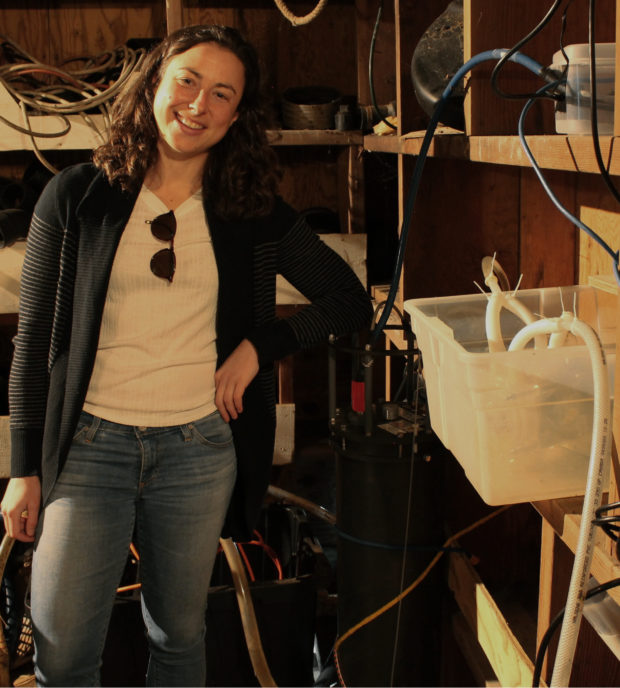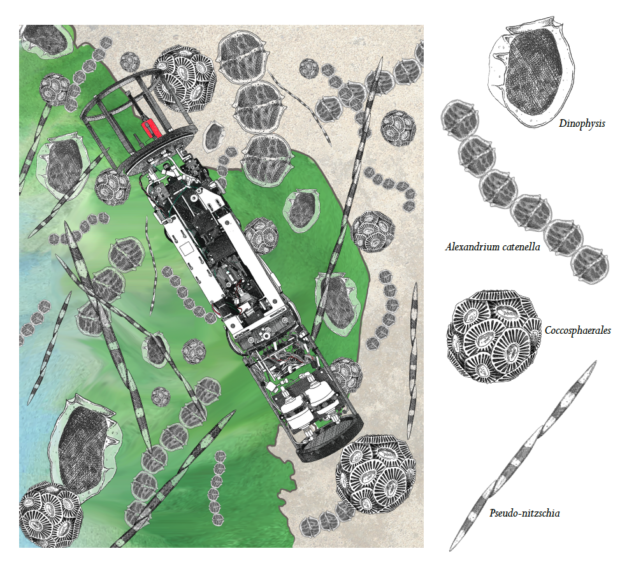Detecting deadly algae
Biologists want to predict outbreaks of harmful algae in the ocean before they happen to help make the seafood supply safer. Katrina Hunter reports.
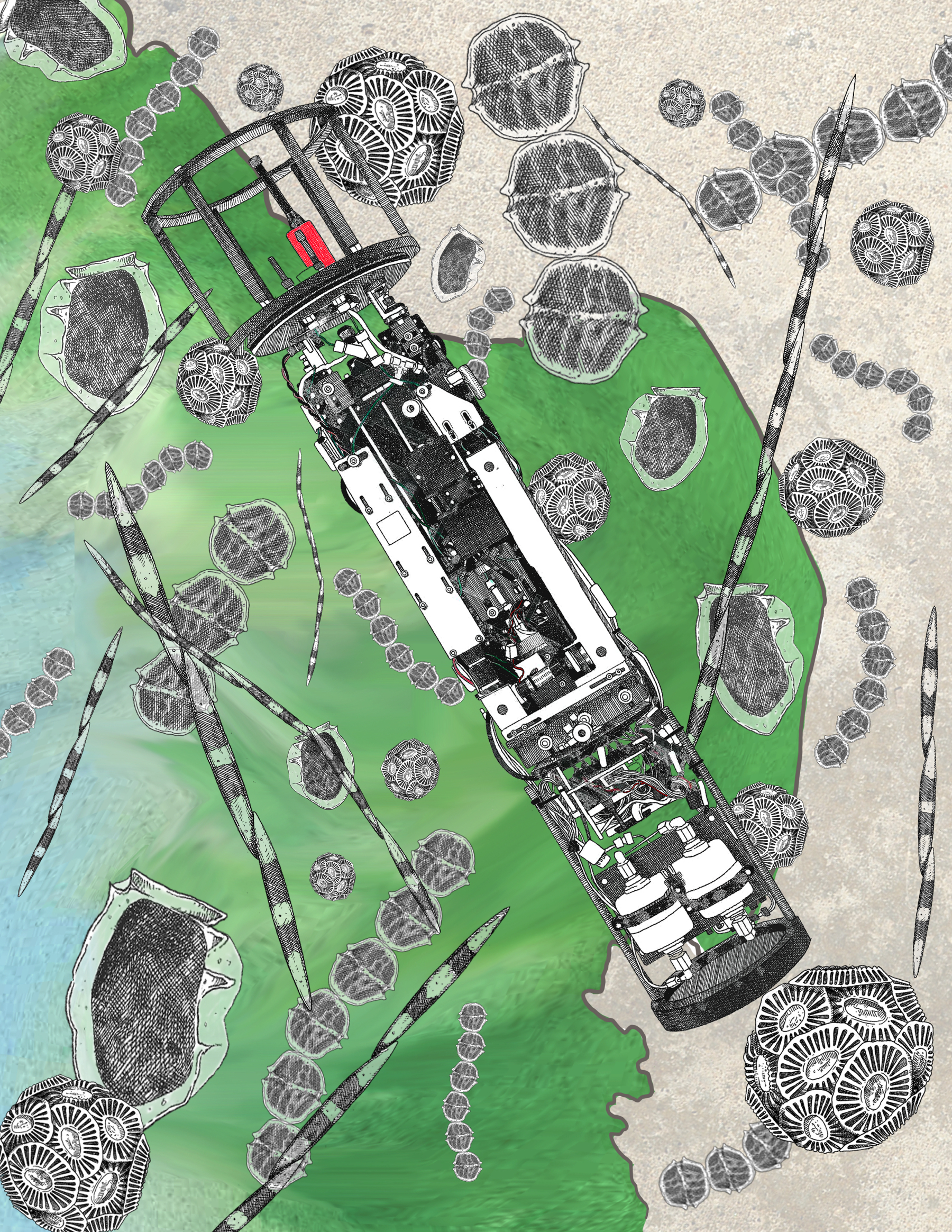
Illustration: Megan Bishop
The report landed in Lisa Campbell’s inbox straight from the Gulf of Mexico. In it was an image of a microscopic, oval-shaped creature, alongside a number that was way too high. The report was telling her that a toxic algae called Dinophysis was spreading rapidly near the coast of Freeport, Texas, for the first time. In just a couple of weeks, a huge annual oyster festival was scheduled to occur, and fishermen would soon begin harvesting oysters for the festival from the very waters where Dinophysis had appeared.
Campbell called health officials and urged them to test the water. When they did, they found dangerously high levels of Dinophysis in the water, and its toxins in the oysters. So they trucked in Louisiana oysters for the festival, and a potential disaster was averted.
Campbell credits a machine called a cytobot with saving the festival. It’s a new robot that oceanographers can deploy on and offshore, and it samples water around the clock, checking for organisms like Dinophysis. Massive contamination by these harmful organisms occurs during events known as harmful algal blooms. These blooms are happening more often, and are becoming more deadly.
Oceanographer Raphael Kudela at UC Santa Cruz hopes that cytobots will not only help scientists understand why these blooms are happening but also, perhaps, prevent some of their worst effects. He has deployed three of the machines around the California coast and hopes that they might become the heart of an early warning system for toxic water conditions caused by harmful algae.
“We see sea lions dying on the beach, and then we start to look at the bloom,” Kudela says. “We are very responsive rather than proactive.”
Now, Kudela and other scientists want to develop forecasts of harmful algae blooms similar to weather predictions. They hope that their flotilla of automated, algae-detecting cytobots might get them closer to that goal.
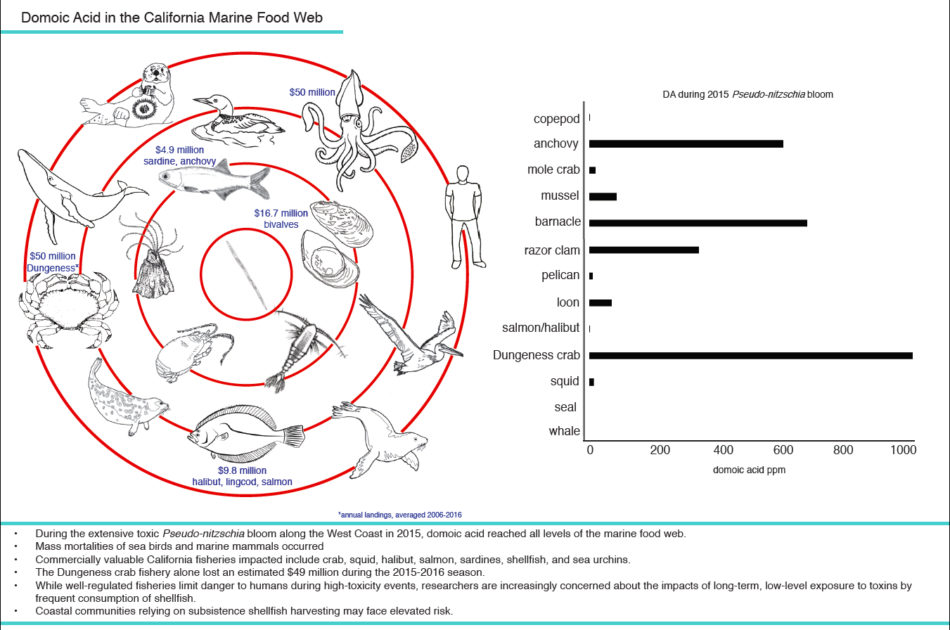
The 2015 harmful algal bloom caused widespread damage to California’s marine wildlife and fishing industry. Image Credit: Anna McGaraghan. An illustration of the impact of the 2015 harmful algal bloom on California’s food web is on the left. The inner ring depicts the alga, Pseudo-nitzschia, responsible for producing the toxin domoic acid, which at certain concentrations can be harmful to marine wildlife. Each continuous ring represents how toxic algae can move up the food chain impacting commercial fisheries and apex predators such as humans, otters and whales. On the right, the peak concentration of domoic acid in marine organisms during the 2015 harmful algal bloom is given, some of which are fished commercially.
A Blooming Problem
The tiny organisms responsible for harmful blooms are phytoplankton. These floating plant cells, or algae, are responsible for producing half of the planet’s oxygen, and come in many shapes and size.
There are thousands of species of microscopic algae, and most are not harmful. But less than 1% of algae can produce dangerous toxins that harm or kill people and wildlife, upon reaching certain levels.
Scientists detect the cycles of different algae usually by surveying the water from a boat or onshore. But these detections are often not rapid enough. By the time scientists bring a sample back to the lab, which can take up to a week to analyze, the population of a harmful algae may have grown exponentially.
There are only a dozen species on the west coast known to produce toxins harmful to humans and wildlife at any given point. But for scientists, it still remains a game of Russian roulette to predict which harmful species will spread with changes in ocean patterns from year to year.
In 2015, for instance, the largest, longest lasting, and most toxic bloom of algae on record hit the west coast of North America hard. An unprecedented bloom of Pseudo-nitzschia australis was first discovered by a plankton researcher in Monterey Bay in late spring. Pseudo-nitzschia produces a neurotoxin called domoic acid that is harmful to fish, birds, mammals and humans.
Enough exposure to the toxin produced by the harmful algae in worst cases can cause permanent memory loss in humans. The toxin enters the ocean food web through filter-feeding animals such as shellfish or anchovies, which ingest the microscopic algae and accompanying toxin.
Pseudo-nitzschia blooms typically only last for a few weeks in spring in places like the Monterey Bay. But in 2015, the water temperatures were warm enough for blooms to persist for months, and occur further north in typically colder regions up to Alaska, where the algae Pseudo-nitzschia remain naturally very low.
Seabirds perished across multiple states from consuming contaminated anchovies and sardines. At least 30 whales were killed, with the algal bloom suspected in their deaths. Sea lion pup strandings occurred at an unprecedented rate, while adult sea lions seized on coastal highways. Remote tribal groups in Washington no longer had access to their primary food supply. Advisories to surfers to stay out of the water dragged on for months. The closure of the commercial Dungeness and rock crab industries in California led to losses of $30 million for these fisheries alone from 2015 to 2016 (see above graphic).
“We would never have anticipated that a crab fishery was going to close down,” says Clarissa Anderson, Executive Director at the Southern California Coastal Ocean Observing System. During the unprecedented 2015 bloom, she was a researcher in Kudela’s lab working on forecasting algal blooms. She says it’s hard to predict which animals will suffer during harmful algae events. “Will anchovies and sardines get hit this year? Will we see it in pelicans?”
To build a better bloom forecasting system, it is crucial to know which harmful organism is in the water, just as the population is taking off. To do this, Kudela and his team deployed in early 2017 one of the cytobots at the Santa Cruz Wharf, a long-term monitoring site for the group. The team already takes weekly samples using microscopy to look for algae in the water and their toxins in mussels that hang in bags under the wharf. The cytobot samples continuously, every 20 minutes, so the scientists hope it will tell them exactly when a particular algae hit unsafe levels in the water.
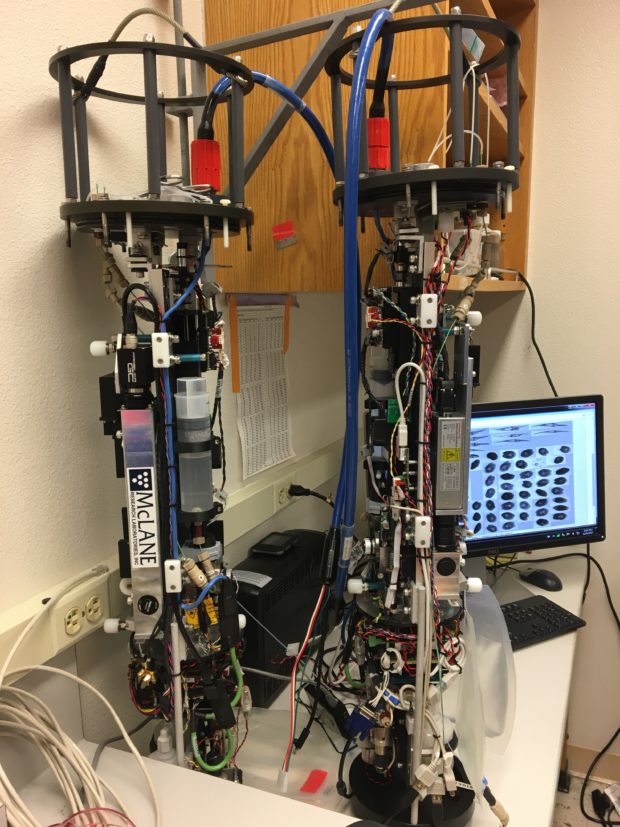
An imaging flow cytobot (IFCB) undergoing testing in Raphael Kudela’s lab at the University of California, Santa Cruz. Image Credit: Alexis Fischer
Prediction is Hard
The game-changing cytobot instrument for studying plankton ecology was developed by Woods Hole Oceanographic Institution and MIT scientists. “It is a truly revolutionary, transformational technology,” says Don Anderson, senior scientist at Woods Hole Oceanographic Institute.
The cytobot captures more data about the plankton ecosystem than a water sample and a microscope. Using a cytobot, “You get hundreds of thousands of images a day and during a harmful algal bloom, probably around 12 million images,” says Don Anderson. “Humans can’t deal with that.”
Alexis Fischer, a researcher in Raphael Kudela’s lab at UC Santa Cruz, is working closely with the cytobot hidden under the Santa Cruz wharf. On a recent visit in January, she visited the machine for a routine maintenance check-up. She opened a locked storage room under the Santa Cruz wharf, marched past surfboards and supplies strewn across the floor to a noisy pump sitting on a shelf. As the pump vacuumed up sea water from under the wharf, a camera captured images of each organism in the sample. A laptop sat close by, displaying colorful images of these plankton cells.
“That is a coccolithophore,” Fischer said, pointing to a tiny cell resembling coral floating across the laptop screen. “We have to screenshot this!”
The machine is giving Fischer and Kudela a more in-depth look at plankton than has ever been possible. They hope to use this data to answer questions like, if 2018 was warmer than 2017, how did the warmer temperatures affect plankton communities?
About 365 miles south of the wharf, in San Pedro Bay, is a shellfish farm that is six miles offshore. The team is collaborating with the facility to launch one of the cytobots to help their operation. Fish farms are vulnerable to harmful algae outbreaks. The farms are often located in marine areas, ideal for plankton loving shellfish to feed on algae in the water, but also where harmful blooms can occur.
The cytobot is being moored to a buoy that will send images and counts of the plankton to the cloud in real time to Kudela’s lab in Santa Cruz. Using image classification similar to facial recognition software, a machine-learning algorithm automatically identifies the plankton in the water of the fish farm. Hopefully, providing an early warning of toxic blooms so that the farm can pull the lines out of the water or hold the shellfish until they naturally purge the toxin.
“We are getting to a point where we can instrument the ocean, not just for research, but for water quality management,” Kudela says.
“Now we have a visual record that we can interpret while the ship is sampling just like we are marching across a prairie or forest or wetland to document the different plant communities.”
Jim Cloern is a scientist with the U.S. Geological Survey. He has been studying the phytoplankton community in the San Francisco Bay since the late 1970’s through samples taken from bay wide cruises and is also working with Fischer and Kudela to pilot one of the three cytobots.
“The traditional way of looking at phytoplankton is expensive and laborious,” says Cloern. “Over the course of 40 years in doing this in the Bay, we have only analyzed 1000 samples.”
And using the instrument to measure in detail what is happening with problematic microscopic algae in the San Francisco Bay has only begun to take shape for the scientist.
“Now we have a visual record that we can interpret while the ship is sampling just like we are marching across a prairie or forest or wetland to document the different plant communities, as we go along a transect,” says Cloern.
It’s the future, but can it run?
Still, there are major hurdles limiting the potential for a network of algae-detecting cytobots in the coastal ocean. One is training people how to use it. The technology behind the cytobot is complex, requiring the training of an engineer rather than a biologist for it to run. The other is cost. The price point for one cytobot when all is said and done hovers around $150,000.
“Right now, we would see them all over the bay, in every coastal harbor, if the price was an order of a magnitude less,” says Fischer. “If this was $10,000 or even maybe $1,000, I think we would definitely see it more widely adopted.”
Scientists from Kudela’s lab and Cloern recently discovered toxins from four different harmful algae species occurring all at once in the mussels found in the San Francisco Bay. There are no commercial fisheries in the bay, but there is evidence from online blogs that people do harvest the mussels. And there are no regulatory agencies in the bay to warn sport harvesters when it is unsafe to eat the mussels.
Cloern is anxious to learn more about how problematic algae get into the bay. He is running the instrument during all of the 20 yearly USGS cruises that roam the bay collecting water and plankton samples from the Golden Gate, where the mouth of San Francisco Bay touches the open ocean, further into the estuary. He wants to learn if the populations of harmful algae in the Bay are occurring independently of what is happening in the coastal ocean.
He says that while there is still much to learn about how to operate cytobots most effectively if anyone can figure out how to harness these machines to prevent more disasters like the 2015 West Coast algae bloom, it will be Kudela.
“It is something Raphe’s team is slowly figuring out,” Cloern says.
In this podcast, Anna Katrina Hunter speaks with scientists Alexis Fischer and Clarissa Anderson about harmful algal blooms and current efforts to predict the blooms before they occur.
© 2018 Anna Katrina Hunter / UC Santa Cruz Science Communication Program
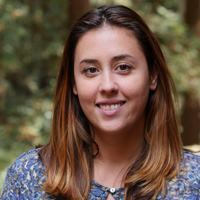
Anna Katrina Hunter
Author
B.A. Environmental Studies
Internship: UC Santa Public Affairs Office, Big Picture Science Radio, Inside Science News, Purdue University News Office
I used to love painting landscapes at the kitchen table with my grandmother. When we’d put away our brushes, I’d venture outside to explore the wild oaks, birds, and olive trees depicted in her paintings. Years later, I found myself looking through the lens of a microscope at a glossy red mite with a yellow swirl reminiscent of a paintbrush stroke decorating its back. In this tiny, profound moment, I realized that my love for scientific discovery married itself perfectly with my appreciation for the artistry of nature. I became an entomologist, studying insects in agriculture, but soon felt frustrated by this narrow focus. As a science writer, I hope to recapture my awe at nature’s beauty and to share it with those who have yet to appreciate the hidden realms that I once glimpsed through my microscope.
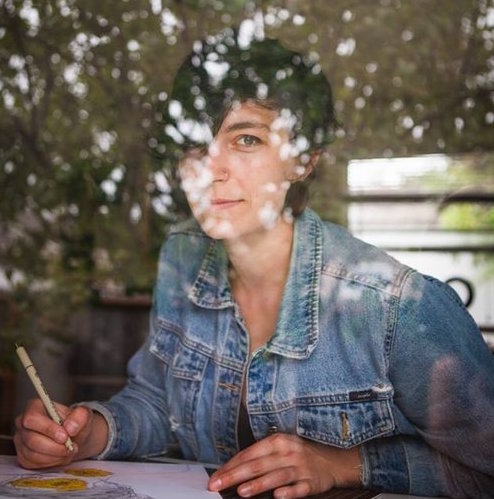
Megan Bishop
Illustrator
B.S. (Botany) Humboldt State University
Internship: Bartel’s Science Illustration Program, Cornell Ornithology Lab
Bishop’s love for the arts and sciences has been in place since she was a child. Growing up she poured over Henry Vandyke Carter’s medical illustrations, watched all the BBC nature documentaries and loved being outside to catch lizards and watch birds. Though the arts and sciences were both passions of hers, the marriage of the two seemed out of reach. During her years as a botany student, she continued to develop her illustration skills as a tool for studying and began to see the possibilities of a career as a science illustrator. Bishop hopes to use her art as a means to communicate scientific information to the public and show people that art holds an important place in the sciences.
